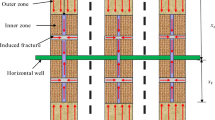At present, the wellbore overflow in a fractured gas reservoir is mainly characterized by qualitative methods. The development of quantitative methods would need a thorough theoretical study of the correlation between the overflow phenomenon and the complex drilling characteristics of the formation. In this paper, the authors have established a mathematical model of the deep-wellbore multiphase flow considering the parameters of wellhead pressure, annular equivalent diameter, wellhead gas flow, and drilling fluid displacement. The model has been solved by the Runge-Kutta method. The results show that the increase in the surface overflow increment correlates with the increase in the well depth. With increase in the surface overflow, the wellbore gas volume increases. When the local surface overflow is Qg = 0.2 m3 and the well bottom depth is 6000 m, the overflow volume at the bottom of the well increases from 0.000505 to 0.000649 m3. When the ground overflow increment is doubled, the gas volume at the depth of 6000 m increases by 34.72%.



Similar content being viewed by others
References
K. S. Bjorkevoll, D. O. Molde, R. Rommetveit, et al., “MPD operation solved drilling challenges in a severely depleted HP/HT reservoir,” IADC/SPE Drilling Conference, Orlando, Florida, USA (2008).
J. Xiao, Q. Li, and H. Yin, “Micro-flux control pressure drilling system,” Oil Field Equip., 4, 008 (2013).
Q. Junbo, C. Ping, M. Tianshou, et al., “Design and test of downhole micro-flow device for monitoring overflow,” Pet. Drill. Tech., 5, 33-36 (2012).
X. Kong, Y. Lin, Y. Qiu, et al., “A new model for predicting dynamic surge pressure in gas and drilling mud two-phase flow during tripping operations,” Math. Probl. Eng, 4, 1-16 (2014).
H. Han and X. Kong, “Study on migration characteristics of plugging balls in shale gas reservoir during plugging to fracturing vertical section,” Chin. J. Appl. Mech., 38(01), 249-254 (2021).
H. M. Santos, E. Catak, J. I. Kinder, et al., “First field applications of microflux control show very positive surprises,” IADC/SPE Managed Pressure Drilling & Underbalanced Operations, Galveston, Texas, USA (2007).
H. M. Santos, P. I. Reid, J. L. Jones, et al., “Developing the micro-flux control method. Part 1: System development, field test preparation, and results,” SPE/IADC Middle East Drilling Technology Conference and Exhibition, Dubai, UAE (2005).
S. Syltoy, S. E. Eide, P. C. Berg, et al., “Highly advanced multi-technical MPD concept extends achievable HP/HT targets in the North Sea,” SPE/IADC Managed Pressure Drilling and Underbalanced Operations Conference and Exhibition, Abu Dhabi, UAE (2008).
Acknowledgment
This study has been supported under the Project of Science and Technology Department of Sinopec, Well Control Risk Assessment Technology for Drilling Fractured Gas Reservoirs in Sichuan and Chongqing area (No.: P21069) and the financial support of the National nature science foundation of China (No. 52074018).
Author information
Authors and Affiliations
Corresponding author
Additional information
Translated from Khimiya i Tekhnologiya Topliv i Masel, No. 5, pp. 98–102, September-October, 2021.
Rights and permissions
About this article
Cite this article
Kong, Xw., Zhang, Cj., Jin, Yx. et al. Gas Overflow Model and Analysis in a Fractured Formation. Chem Technol Fuels Oils 57, 865–869 (2021). https://doi.org/10.1007/s10553-021-01317-9
Published:
Issue Date:
DOI: https://doi.org/10.1007/s10553-021-01317-9




